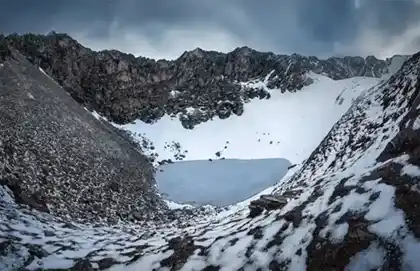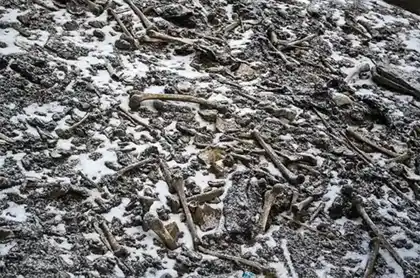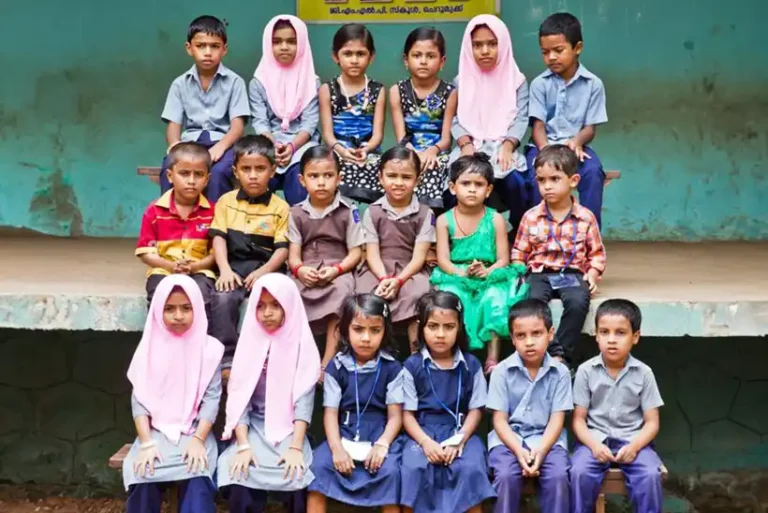
Roopkund, commonly called Mystery Lake or Skeleton Lake locally, is a high-altitude glacier lake in the Indian state of Uttarakhand. The size of the lake varies depending on the season and weather, and it typically remains frozen over. After the snow melts, observers can witness the skeletons, which occasionally remain connected to the flesh and maintain excellent preservation. Up to now, researchers have discovered an estimated 600-800 human skeletal remains at this location. The local authorities refer to it as a “mysterious lake” in tourism marketing.
The mysterious discovery in the lake
Situated in the Himalayas at an elevation of nearly 16,500 feet, the lake remains frozen for most of the time. The size of the lake, a glacial tarn known as Roopkund, varies with the season and the climate. This lake resides in a mountain cirque encompassed by snowfields and frequently battered by storms. Five long days of hiking separate it from human civilization. A forest ranger discovered hundreds of bones and heads during the winter of 1942 near the lake. Many more were laying on the bottom of the lake as the snow and ice melted that summer.
The Anthropological Survey of India funded several research expeditions in 1956. However, the first voyage had to turn around due to a snowfall. But two months later another expedition succeeded and made it back to Calcutta with remains for analysis. The bones were between five hundred and eight hundred years old, according to carbon dating, a still-unreliable scientific advancement.


The stories and theories of skeleton lake
The Roopkund mystery attracted the keen interest of Indian scientists. The Roopkund mystery is the subject of numerous tales and speculations. Scholars believe that holy men deliberately ended their lives through ritualistic means at the lake. Or perhaps the deceased were a section of an army from a failed effort to conquer Tibet. Alternatively, they might have constituted a group of traders en route to Tibet who lost their way. It is possible that this site served as a burial ground for epidemic victims in order to contain the spread of disease.
The villages below Roopkund held their own explanation, preserving it through folk songs and stories passed down through generations. The villages are on the route of the longest and most dangerous pilgrimage in India. The trail crosses the slopes of the Trisul Mountains. The local residents believe that Nanda Devi — a manifestation of the goddess Parvati — lives with her husband, Shiva.
Long ago, Nanda Devi travelled from her home to a distant realm, where the king and queen treated her rudely. Nanda Devi, enraged, cursed the realm, bringing drought, disaster, and maggot infestation in the milk and rice. The royal pair set out on a pilgrimage to please the goddess. The king, who enjoyed amusement, violated the pilgrimage’s ascetic customs by bringing along a bevy of dancing courtesans and musicians. When Nanda Devi saw the display of earthly delights, she became enraged and pushed the dancing females into the underworld. The pits in which they are said to have sunk are still visible on a mountainside. According to legend, she sent down a hailstorm and a whirlwind. Any traveller on the path of death was then thrown into the lake. Their remains act as a warning to anyone who would disrespect the goddess.
Who were they and where did they come from?
The majority of the prevailing theories were quickly discarded by scientific analysis. The bones had no signs of conflict, ritual suicide, homicide, or widespread illness. The bones were those of men, women, and children; they weren’t those of a vanished army. Aside from a single iron spearhead, no weaponry or horses were discovered. Roopkund wasn’t a cemetery either. The majority of the people there were healthy and between the ages of eighteen and thirty-five.
Even though Roopkund is only 35 miles from the Tibetan border, the mountains act as an impenetrable barrier. The research dispels the myth of lost traders in the mountains. There was no trade route between India and Tibet that ever existed in the region. The bodies were not discovered with any trade goods or beasts of burden, either.
People might have been travelling nearby because of a pilgrimage that goes by the lake. According to studies, the earliest reliable tales of pilgrimage in the region originate from the late 19th century. Although inscriptions found in nearby temples from the 8th to the 10th centuries, “indicate possibly earlier beginnings.” Numerous leather slippers, fragments of parasols made of bamboo and birch bark, and bangles made of seashells and glass were among the artefacts found. On their pilgrimage, Nanda Devi devotees wear bangles and carry parasols. According to scientists, a “mass death during a pilgrimage event” may be the reason for some of the remains discovered at the site.
There was a local myth before the remains were found. This suggested that during a severe hailstorm in the 9th century, a group of pilgrims were killed at the lake. The skeletons’ 800 AD age may give the once-mythic tale some validity.


Research and findings about skeleton lake
The remains are believed to belong to a single group of people who died simultaneously in a single tragic event in the ninth century. All these presumptions may not be accurate, according to the most recent five-year study. The research team included 28 co-authors at 16 institutions in India, US and Germany. The team was led by Eadaoin Harney, a doctoral student at Harvard University.
“It is still not clear what happened at skeleton Lake. But we can now be certain that the deaths of these individuals cannot be explained by a single event.” Eadaoin Harney said.
The most likely scenario involves people who lived sometime in the 1800s. The bones are thought to belong to people who lived between 1600 and 1900 AD. The second set of bones is older and dates all the way back to the year 800 AD. They were discovered in the same location. They share DNA with modern Indians and Pakistanis, as well as other people from South Asia.

The Greek Connection
Interestingly, the genetic study revealed that the deceased were different people: one group shared genetic characteristics with today’s South Asians, while the other group was “closely” related to today’s Europeans, especially those who lived on the Greek island of Crete.
Scientists can’t explain why a group of individuals travelled from modern Greece to a region situated at such a high altitude. There is no local legend about a group of Greeks visiting the region in the 19th century that may provide clarity on the mystery. They published their unusual discoveries in the journal Nature. It is believed that thirteen of the fourteen skeletons in the first group belonged to Greeks who lived around the same time. The scientists were unable to formulate a theory to explain why they all died so quickly one after the other or why they buried their remains so close together. The research also uncovered that the Greeks enjoyed good health before their mysterious deaths, which may never find a solution.
After all of the research and study, a few answers have begun to emerge, but much remains unknown.



